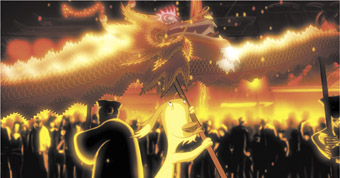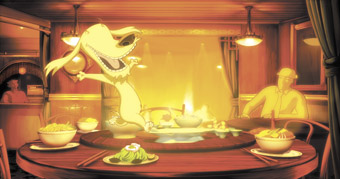from chinatown to china
dan edwards on an australia-china animation co-production

Sweet and Sour
CHINATOWNS HAVE LONG BEEN A KEY SITE OF CROSS-CULTURAL EXCHANGE IN AUSTRALIAN CITIES, SO IT’S APPROPRIATE THAT THE FIRST AUSTRALIA-CHINA ANIMATED CO-PRODUCTION TAKES AN IMAGINARY CHINATOWN AS ITS SETTING. BRINGING TOGETHER NEW TECHNOLOGY AND YOUTHFUL ANIMATORS WITH THE HAND-DRAWN WORK OF ONE OF THE WORLD’S OLDEST ANIMATION STUDIOS, THE 17-MINUTE SWEET AND SOUR MARKS AN EXCITING FORAY INTO ASIA FOR AN INDUSTRY TOO OFTEN BLIND TO THE DEVELOPMENTS, INNOVATIONS AND OPPORTUNITIES TO OUR NORTH.
Sweet and Sour originated with Adelaide’s youthful People’s Republic of Animation, a company whose short films like Carnivore Reflux and Fritz Gets Rich have quickly put them at the forefront of Australia’s small but active animation sector. The Chinese contribution came from the venerable Shanghai Animation Film Studio (SAFS), renowned for hand-drawn animation work evidenced in such classics as Sun Wu Kong (The Monkey King, aka Uproar in Heaven, 1965) and Nezha nao hai (aka Prince Nezha's Triumph Against the Dragon King, 1979).
Sweet and Sour revolves around a cute stray dog living in a cold, bleak metropolis, whose world is transformed one night when he inadvertently stumbles upon Chinatown’s golden carved gateway. He enters, passing into a warm, dynamic world of startling sights and tantalising aromas. Like so many others, the little dog begins his love affair with Chinese culture by sampling the myriad culinary delights on offer, from noodles to soups to steamed dumplings. However, after revelling in the richness of all things Chinese for several nights, the romantic image is suddenly shattered when he realises that he and his canine comrades may be destined for the menu. Chinatown’s hospitable ambience is suddenly transformed into a threatening air of menace, full of monsters and knife-wielding chefs, and the dog flees in terror. Enticing scents eventually lure him back, and before the film’s end he manages to find salvation, along with his four-legged friends (including one stray turtle!), in Madame Li’s Vegetarian Restaurant.
Given the vast cultural and linguistic differences between China and Australia, Sweet and Sour’s writer-director Eddie White knew he would need some serious help when he dreamt up the idea of an animated co-production between the two nations. Fortunately, the Australian Shanghai-based producer Barry Plews and his company Reckless Moments were already working with the Shanghai studio developing an animated TV series when the PRA approached them with the co-production proposal. Aware of the PRA’s reputation and track record in Australia, and always eager to further the cause of transnational artistic partnerships, Plews agreed to come on board as executive producer, and the first animated China-Australia co-production was born.

Sweet and Sour
Ironically, the concept of Chinatown was the first cultural stumbling block when the Shanghai animators read Eddy White's script. “It took quite some time to get the 'idea' of a Chinatown in a foreign country across to the Shanghai animators”, recalls Plews. ” They had no concept of it. One of the issues that needed clarification was that 'Chinatown' was not China…we had to do sessions where we showed the Chinese animators extensive folios of Chinatown photos from around the globe.”
Despite the SAFS’ international reputation, Sweet and Sour is only the second co-production undertaken by the studio. Plews and his associate producer Hu He “ended up being the conduit and the bridge, interpreting each side's expectations and looking after both side's creative interests.”
The result of all these cross-cultural negotiations is best seen in the film’s gorgeously sensuous Chinatown. Modeled on a dream-like 1930s Shanghai-style reality of bright colours, sensual women, raucous restaurants, gambling dens and bustling street life, the astonishingly detailed setting and expressive fluidity of the main character’s movements were borne of the two teams’ respective strengths. The backgrounds and some characters relied on the PRA’s skilful use of digital technology, while the cute lead was designed by the Australians and drawn by the Shanghai team. The finished film marries the SAFS’ hand-drawn characters with the PRA’s warm, digitally-generated backgrounds to beautiful effect.
Since premiering at the 2007 Adelaide Film Festival, Sweet and Sour has played at festivals around the country and garnered the Yoram Gross Award for Best Short Animation at the Sydney Film Festival last June. The Hong Kong International Film Festival will unveil the film for Chinese audiences in March 2008, and approval for Chinese mainland screenings was granted at the end of October 2007.
Perhaps more exciting than Sweet and Sour’s current success is the prospect of future collaborations. Despite the cultural divides that had to be bridged in the course of working with an Australia company, according to Plews the Chinese animators greatly enjoyed the experience. The two sides are now working on developing a feature-length project. A 'Memorandum of Understanding' was signed in June and two potential movies are currently being discussed: a film entitled Train to Never Was, and another about Christmas. Plews says they’re “leaning towards the former”, but will make up their minds before the end of 2007.
Given the level of artistry achieved in Sweet and Sour, the prospect of a feature-length co-production is an exciting one for animation fans. If Sweet and Sour has a weakness it’s the lack of narrative sophistication that so often characterises Australian animation. A longer work will hopefully facilitate the kind of rich storytelling the Shanghai studio has demonstrated in earlier works such as Sun Wu Kong.
China is a nation whose culture is only just beginning to meaningfully respond to outside influences, while Australia’s film community can be depressingly myopic when it comes to influences beyond America or Europe. Joint projects between the two countries can only provide a healthy artistic shot in the arm for both. As Barry Plews says of the many Australian-Chinese collaborations on which he has worked, “The most satisfying aspect is that the collaborations actually happen and that they realise such interesting outcomes. These are often very difficult and complex undertakings and they test everyone involved. Many of the Chinese artists with whom we work have never worked with foreign artists or producers before. Collaborations confront cultural differences head on, and the artists have to create within a moving landscape of cultural chasms and fault lines. It's no mean feat for any of them. The pleasure is the journey's end. Always.”
Sweet and Sour, director Eddie White, producers Sam White, Hugh Nguyen and Ren Zhong Lun, The People's Republic of Animation, Shanghai Animation Film Studio, Reckless Moments, 2007
RealTime issue #82 Dec-Jan 2007 pg. 20






